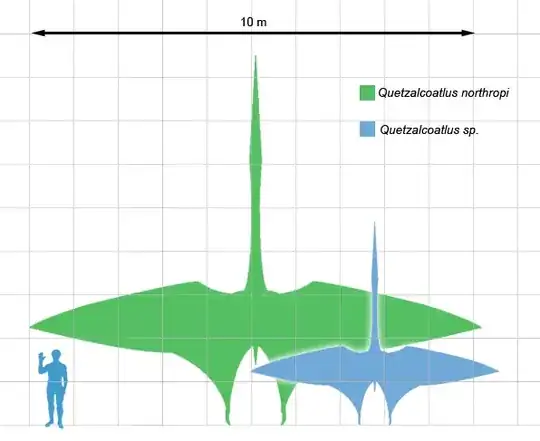A wind is not going to make flying easier. It makes taking off easier, but that is it. Flying is relative to the air. So, wind may boost or lower your speed versus the ground, but it doesn't affect flying once you are airborne.
Soaring is probably possible. It is actually possible for a very strong Bicyclist to get airborne and remain airborne by pedaling. http://www.telegraph.co.uk/news/newstopics/howaboutthat/10177573/Bicycle-powered-helicopter-wins-Canadian-inventors-250000-prize.html
Of course, gliding/soaring itself isn't a problem given the popularity of hang gliding.
Aspect ratio is the ratio of the length to width of a wing. An albatross has an aspect ratio of more than 10:1. High aspect ratio makes for a more efficient wing. Increasing the aspect ratio reduces the sinking speed of the wing when soaring. In terms of wing loading, N/m2 large birds are in the 75-100 N/m2 range.
Let's say the beast has a weight of 150kg (or 330lbs). There are 9.8 N/kg. Let's call it 10 N/kg for simplicity. We have 1500 N. 1500 N divided by 75 N/m2 equals 20 m2. If we approximate the wings as rectangles (which they wouldn't be all the way to their ends), 10x*x=20m2 is their area just to get this airborne let alone with a rider. x=1.42m. That is a wing width of 4.65 feet at the wing's base and a wing length of 46.5 feet for both wings together or 23.2 feet per wing. That is unmanageably long.
Of course, soaring alone (which is what fixed wing aircrafts do) is not enough. Powered flight by flapping is required at least occasionally. Birds usually create small puffs of air they force downward with each stroke. These are discrete cylinders of downward moving air when the bird is moving slowly, and the cylinders start to overlap and run together when the bird is flying faster.
Assuming we somehow get around the muscle strength issue, there is an addition problem: the Reynold's number. This is a dimensionless number that describes how reality change as you scale up or down in size. Air moves smoothly over streamline bodies until the Reynolds number hits about 2,000,000. Air moves smoothly over non-streamlined bodies (such as the body of a rider) until a Reynolds number hits about 200,000.
Once you are above this cutoff number, air starts to move chaotically around the flying object. Drag is doubled, and eddies (turbulence) form. Basically, it is not at all clear whether it is possible to reliably push a significant quantity of air downwards in the direction you want it to go while air is moving around the flyer chaotically.
It is really hard to study the reasons why something isn't possible, but I looked a while back during my own research. I couldn't even find robots that were able to flying by flapping their wings above this cutoff. It isn't even a matter of being stronger than normal animals.
An albatross with a streamlined body of length 1 meter long flying at 15m/s has a Reynolds number of about 1,000,000. The Reynolds number is proportionate to speed and length of the flyer (so take the 1,000,000 number and multiply it how much longer and faster you want the creature to move). The creature we are talking about is 2 meters long at a bare minimum (the wing width is 1.42 meters without a rider). So, we are talking a Reynolds number of 2,000,000 at very least without a rider and flying very slowly in ideal conditions with ridiculously long wings. So, barely flying by flapping regardless of its strength.
Make the wings bigger to accommodate the weight of a rider plus riding gear and plus the weight of stuff you might want to carry with you, and this reptile isn't flying. Also, the rider reduces the Reynold's number cutoff simply by being non-streamline and so probably doomed the endeavor right out of the gate.
The larger pterosaurs didn't necessarily violate this limit. We don't know if they could do powered flight at all or what weight they were. There are even questions surrounding their supposed wingspan.
